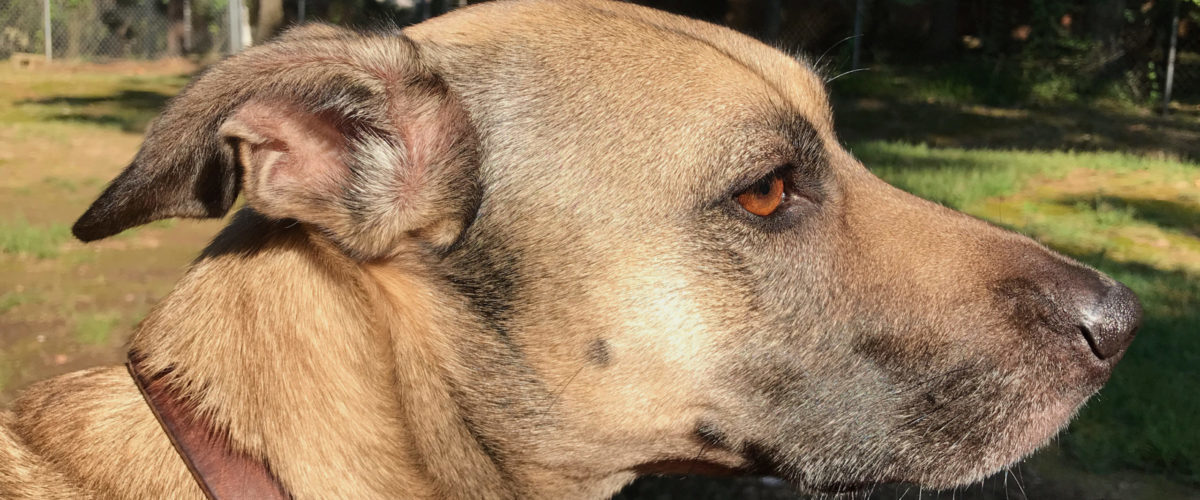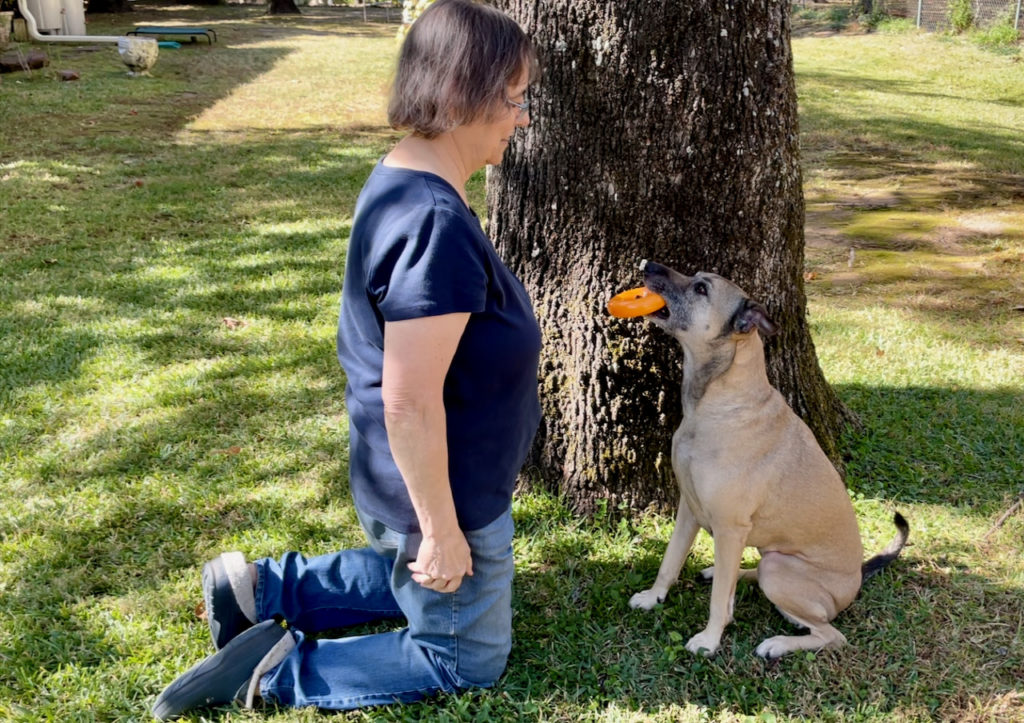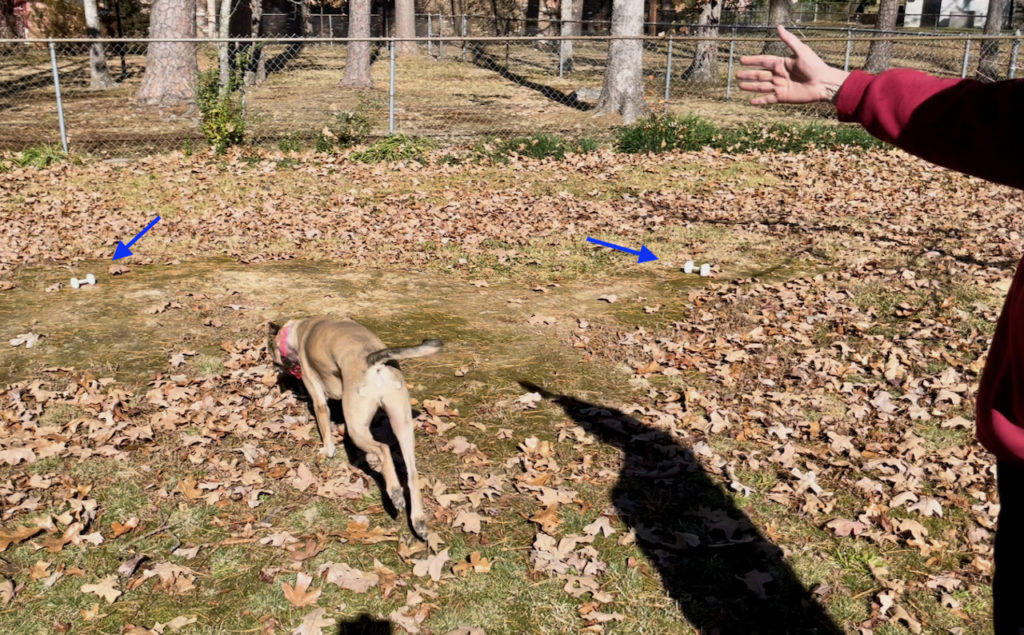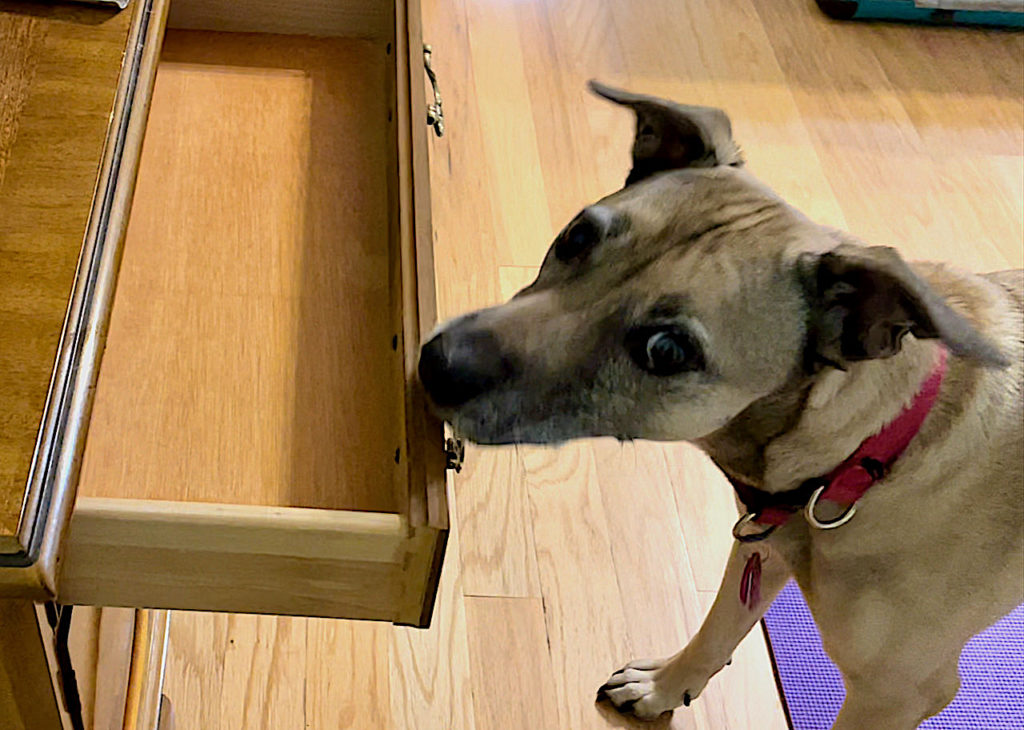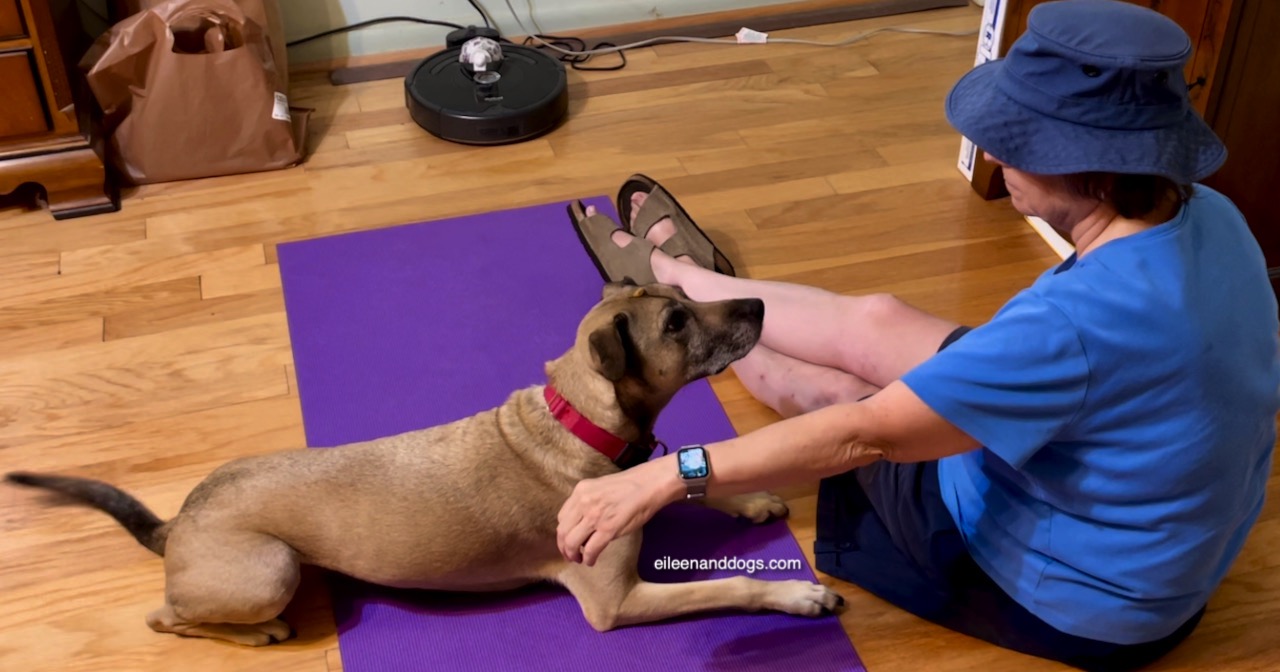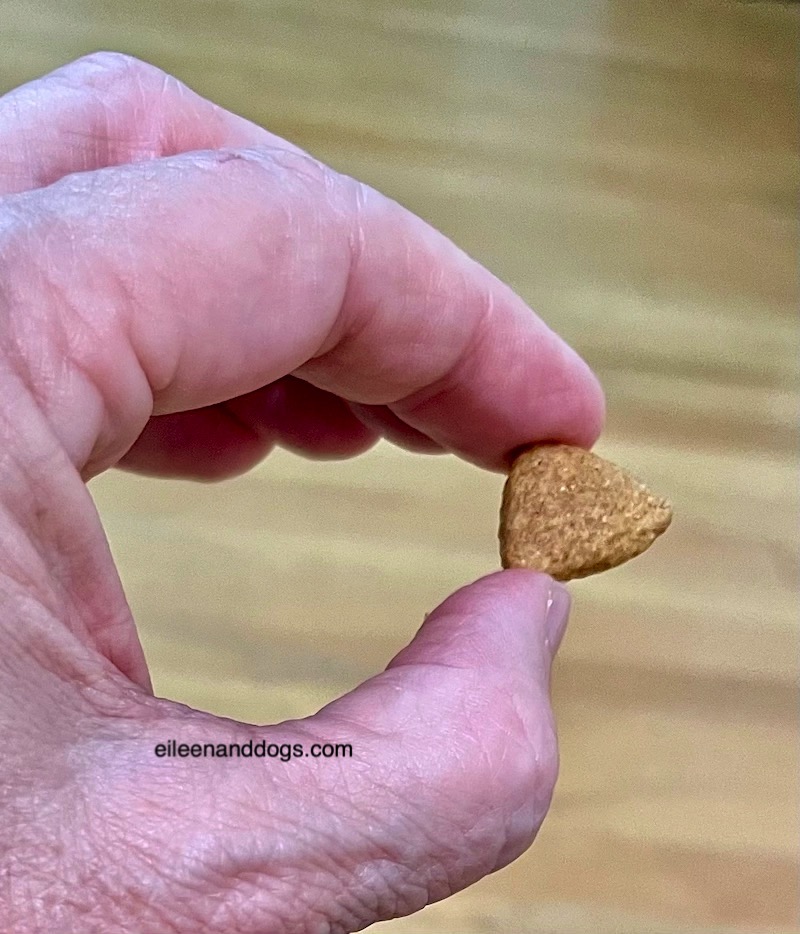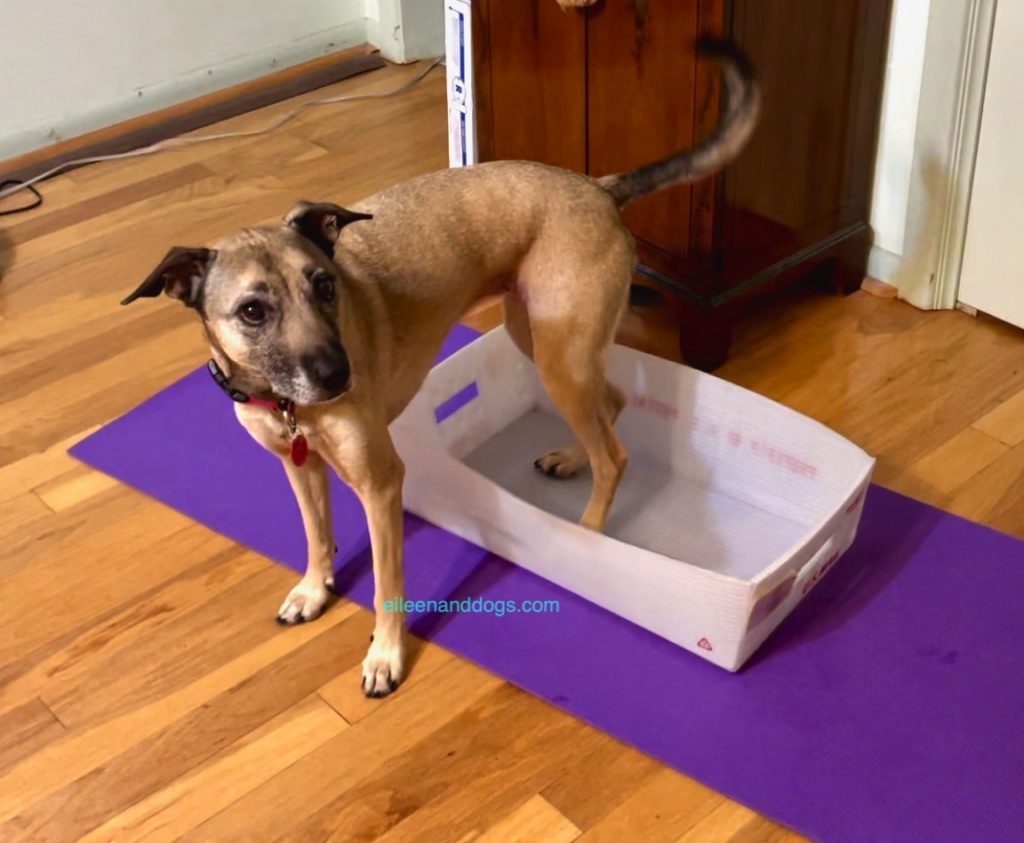Clara’s Intermediate Trick Dog Title: Three-Minute & Three-Month Behaviors
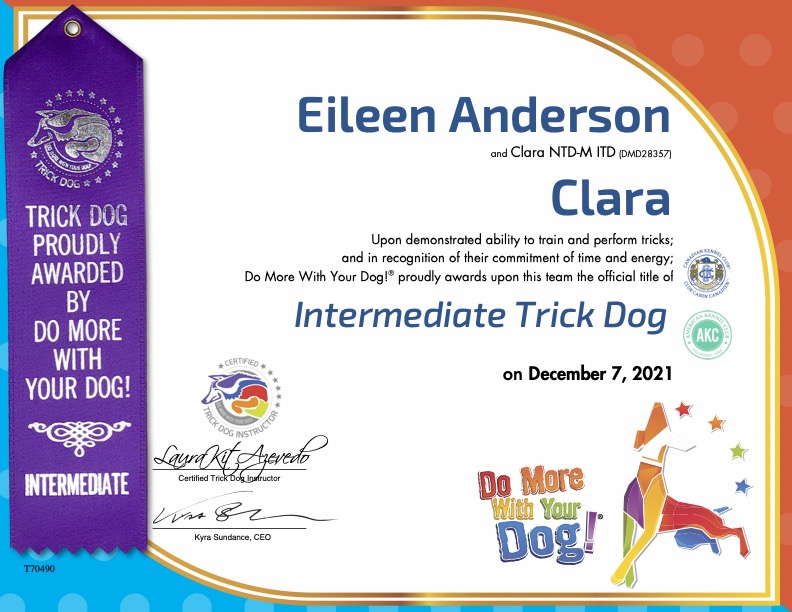
Hurray for Clara: we got her Intermediate Trick title from Do More With Your Dog this week. It got me thinking (surprise!). We had the beginnings of a lot of the tricks already from previous work. Am I achieving my goal of widening her palette of behaviors?
Foundations
Even if you are a sloppy trainer like me, if you’ve done a lot of training over the years and built some foundations, you can often sit down and train something new quickly. Sue Ailsby calls this training “three-minute behaviors.” And truly, a couple of the new tricks still took only a few minutes.
Jumping a baton was one of those. Clara knows a hand target, and she knows a 3/4-inch diameter PVC pipe means jump. (If I had used a piece of dowel, she would have bitten it instead!) The hand target is allowed, so I sat down and targeted her over the bar and gave my “jump” verbal. I mentioned in a previous post that she, alone among my dogs, responds to the verbal. My agility dogs never needed to learn it. She probably didn’t need it either, in this situation. But I included it because I’m a word-oriented human.
Anyway, I could have fancied up the trick. I could have taught Clara to jump the bar back and forth without a hand target, as a chain, or with repeated verbals. But that would have taken a long time for very little gain. Plus, she’s 10 years old and doesn’t need to do a lot of repetitive activity.
I’ll come back to the “How solid do I want to get the trick?” question in the ethics section below. I’ll just say here that getting behavior is by far the easiest part of training for me.
The hardest trick in this batch was the hold of an object. Luckily, I struggled through teaching a hold first with Summer. God knows how long it took, since teaching the hold was new to me, and it’s difficult. Hint: if you’ve never done this, the hard part is teaching them not to drop it when you reach your hands toward it. Oh no, wait, it’s getting that first duration hold out of a grab. Or maybe getting them not to chew it. And, and.
Clara and I progressed faster, but we still took some months. That was years ago, and I have kept the hold alive as a foundation for other behaviors. So that was easy to perform and record even though it’s a hard behavior.
“Directional casting” was another three-minute behavior with months of invisible work behind it. The trick instructions are:
Dog will be sent by handler to one of 2 or more platforms or low marks. Handler should show dog being sent to at least two platforms in a row. Platforms should be spaced 3–4 feet (~1–1.2m) apart. This trick is about showing the dog understanding and responding to directional cues and not as focused on the platforms.
This is probably easy to train with only two platforms. I say “probably” because I didn’t have to train it. I have worked on a directed retrieve with Clara on and off for years and more seriously this year. She started to “get it” in the spring and I have been generalizing and proofing.
The directed retrieve generalized beautifully to the directed “go to place.”
Finally, Clara had never done jump wraps before, but that was a three-minute behavior too. A benefit of growing up in an agility household.
Matching Law
You expected this section, right?
I don’t like how we performed one of the tricks, but I let it go. It’s the figure 8s around my legs. I don’t like our rendition because I must cue with both my hands and my legs. I feel like a squirming mess to get her to do the behavior. But the person on the demo video for the trick uses both, so I figured my excessive body English would be OK.
We used to have the figure 8s with leg cues only. I messed around with that trick years ago. But leg movement now means something else for Clara: peekaboo. These days, if I move my legs apart, she will get between them and stay. Matching law! I have a verbal cue for peekaboo but not for the figure 8s. So I added the hand cues to the figure 8s for clarity. But I find it inelegant. I love seeing the freestyle dogs do that behavior with no repeated physical cues (that I can see) from the handler.
In another life, maybe. I sat on my trick submission video for about two weeks because I didn’t like how that behavior looked. But I can’t get it clean until I get peekaboo completely on verbal cue. Right now she still cues off my legs for that, with the verbal cue at the probable level of “lady says something when I’m behind her and she’s holding her legs in a certain way.” So squirmy figure 8s it is!
So here is our trick title video. The behaviors are peekaboo (while walking), directional casting, shake hands, fetch-to-hand, figure 8s around the legs, barrel racing (“fly”), baton jumping, target mark (run to a flat target and lie down on it), hold an object five seconds, stay out of sight 20 seconds, jump wraps, and close the door (drawer).
Ethics
My goals with the trick training are 1) enrichment for Clara; 2) get out of a rut and train some new behaviors; and 3) improve my skills.
I noticed that even though I made a goal to train new stuff, I chose mostly behaviors related to things we already knew. It is so easy to focus on numbers: do enough tricks to get the title! But I’ve pushed back. I’ve also picked new things: rolling out the carpet, biscuit on the nose, and peekaboo in its different versions. Also, opening a drawer, although it didn’t make it into the video because of an execution detail.
With a video submission, if all you want is the title, you can take shortcuts. Do as many takes as you want and use the one out of 20 or more that meets criteria. People do that in public competitions as well, of course. In my agility days, I remember seeing trainers whose dogs were not solidly trained, but they had advanced to the excellent level because the people had the means to go to trial after trial until they had lucked into enough qualifying runs. They were competing above their level.
I had this in the back of my mind as I chose, worked on, and recorded tricks. The rules state only that the dog has to do the trick and meet criteria, not that it has to be proofed or even put cue solidly. This is not a public activity; videoing tricks allows you to curate what you show of your training and your results. I wanted to be fair. But many of these tricks were not things I needed to put on cue and get solid.
I submitted clips that were a little above our actual skill level for only a couple of tricks. One was target stick, believe it or not, but only because I used a stick she wanted to bite. A fit of perfectionism on my part that didn’t work out. So even though I turned in a fairly lucky clip of this novice trick where she bopped the end of the stick correctly several times and didn’t bite the ball at the end, I felt the clip fairly represented her ability to touch a target stick. She has been targeting all her life. I picked a hard target stick, then decided the discrimination (don’t bite the enticing ball instead) wasn’t worth the time. I could have switched to an easier stick and gotten a billion targets, but I went with a recording in which she was just learning not to bite the tricky stick.
Another trick I kind of rushed through was “shaking hands.” She had this behavior from husbandry tasks, but I had never alternated feet. I trained enough that she could do this, recorded it, and will probably never ask her to do that again. She changes feet fluently enough when we do nail trims and that’s enough for me.
On the other hand, we worked methodically on the peekaboo/walking trick because it’s important to me. I want to train her to get in that position out in the world when we encounter something challenging for her. And I’ve only started to get three puppy pushups, though the time when that trick would count has passed. We still work on them!
I’ve let my conscience be my guide. I’ve taken the challenges that interest me and only pushed through “for the camera” a couple times, with reasons I hope are decent enough.
Next Time
I’ve realized it’s more interesting for people if I show my method and our progress, warts and all, rather than presenting a finished video and discussing it. So I think that’s what I will do next.
And regarding “warts and all,” here’s a video of two bloopers. The tricks are to run around a tree (our cue for counterclockwise is “away”), and go lie on a flat target. I’ve sent Clara around things forever, but I had never done it from that angle with the tree, and I didn’t have her complete attention. The lying on the flat target problem is self-evident and cute. Clara is delightful.
Related Posts
- Clara’s Novice Masters Trick Dog Title: More Tricks, More Lessons Learned
- Clara’s Novice Trick Title: 15 Tricks and 4 Informative Failures
- Clara’s Stand Disaster and Why She Kept Hopping
- That Damn Roll Out the Carpet Trick
Copyright 2021 Eileen Anderson
